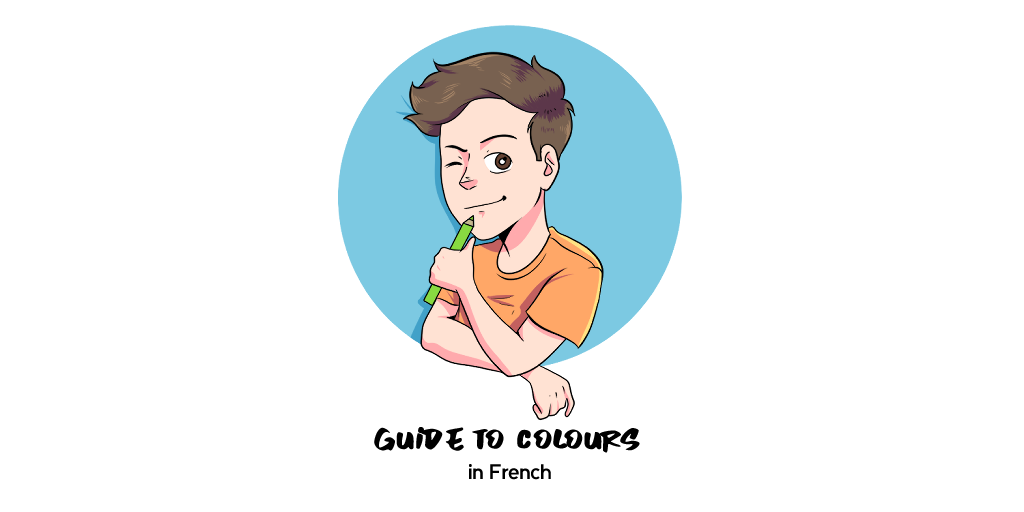Do you need to know how to describe something in more detail than big or small? Learn how to say the different colours in French and use them in normal sentences and scenarios.

The Importance of Colours in the French Language
Knowing how to say the different colours in French will come in handy for many different reasons.
Colours are something that we learn very early in our lives, as they can be used to describe a lot of different things. So, les couleurs (the colours) should be some of the first words you learn in any language.
The use of colour in idiomatic phrases is something we do without noticing because it is so deeply ingrained into our spoken language. For example, we use the phrase “seeing red” when talking about someone being angry, or “having a visit from the green-eyed monster” when talking about jealousy.
Imagine being able to incorporate such natural sayings into your repertoire of French phrases, and how much it will boost your language skills and make you sound more like a fluent French speaker.
Colours are generally used as adjectives, so following the French rule, the adjective must have the same gender and singular or plural agreement as the noun it is describing. For example, if the noun that a colour is describing is feminine, then la couleur (the colour) will change to match it.
As an adjective, the colour will go after the noun, with the only exception being for poetry. For example the line “Je ne regarderai ni l’or du soir qui tombe” meaning “I will neither see the golden glow of the falling evening” from the poem Demain, dès l'aube by Victor Hugo. If you are interested in seeing the full poem or four more, these can be found in this article.
For example, when describing a green dress, la robe (dress in English) is feminine, so green, or vert, becomes verte. Therefore, “the green dress” in French is “la robe verte.” If it’s plural, “the green dresses” becomes “les robes vertes.”
Primary Colours in French
There are three primary colours from which all other colours are formed, so they’re a good place to start when learning colours. Once you know the words for these three colours, you can move on to the others.
The primary colours (les couleurs primaires) are red, blue, and yellow.
Rouge is used to mean red. It is also associated with the verb rougir, meaning “to turn red,” which can be used to describe someone blushing.
Jaune is used to mean yellow. For those learners who follow the Tour de France you may recognise the colour because of the yellow jersey (maillot jaune) that the leader wears.
Bleu means blue. Un bleu in French also means a bruise, which could be due to the fact that les bleus is a phrase that people use to refer to the French national sports teams.
Other Colours in French
So now that you know les couleurs primaires, you can start to learn the other colours that will help you to build more descriptive sentences in French.
Vert or verte means green. Verte is the spelling of the word that you would use if the noun was feminine, while vert is the spelling for masculine nouns.
Orange is probably the easiest colour for you to learn, as it’s the exact same word in English. Still, it is important to remember that the pronunciation is different. Orange is one of the two colours that doesn’t have a feminine and masculine form, so it doesn’t change depending on the noun’s gender being used with it.
Blanc, or the feminine form blanche, means white.
Noir, or noire in its feminine form, is black in English. Noir can also be used to mean “gloomy”.
Gris means grey. Or, if you use this colour to describe a feminine noun, the feminine grey is grise.
Marron means brown. Marron is the second colour, after orange, that doesn’t change its spelling regardless of the noun’s gender that precedes it.
Rose means pink. La Vie en Rose is a very well-known song by Edith Piaf which talks about finding love. This colour is another that doesn’t change depending on the noun, but whether it is plural.
Violet means purple. The feminine version of this colour is violette.
Argent means silver.
Or is gold.
Mauve is light purple.
Crème means cream.
Écarlate means scarlet.
French Words Associated with Colours or Used in Conjunction with Colours
Like English, there are adjectives that are used in conjunction with the colours, which add even more description to the appearance of an object.
Foncé means “dark”. For example, vert foncé would be “dark green”.
Clair means “light”. For example, bleu clair would be “light blue”.
Fluo means “fluorescent”. For example, jaune fluo means “fluorescent yellow”.
Fade means “faded” or “washed out”.
Âtre is a suffix that is used “-ish”. This word is usually used in French poetry.
Vif is used to describe bright colours.
Une nuance means “a shade”.
Using these words in your sentences will help with your descriptions and make them seem even more natural.
Hair Colours in French
The names of colours used to describe hair are slightly different from normal colours. Note that since cheveux is a masculine and plural noun, the hair colours are also in masculine and plural forms.
Bruns is used for brunette hair. This is fairly simple to remember as bruns is like a shortened version of brunette.
Blonds is the name for blonde hair. Similar to the word for being a brunette, blonds is very similar to the word “blonde” in English.
Roux is used to talk about red hair. When using roux in relation to red hair, an easy way to remember it is to link it to the colour rouge, which is “red” in English.
Finally, black and grey hair are referred to simply by their colour names, noir and gris. When talking about dyed hair, you would say “colorés en” (coloured in), then the colour that they have dyed it in.
For example, if you wanted to say, “She has blonde hair”, you would say “Elle a les cheveux blonds.” If you want to say, “His hair is dyed blue,” you would say in French, “Il a les cheveux colorés en bleu.”
Phrases Using Colours
As mentioned at the beginning, there are phrases that use colours to paint an image in the mind. Here are a few that you might recognise or hear being said:
Le Tapis Red is “The Red Carpet.”
Être rouge comme une tomate means “to be as red as a tomato” and is used in reference to be blushing or being sunburnt. Although, for blushing you can also use the verb “rougir.”
Être sur la liste rouge means “to have an unlisted phone number.”
Être dans le rouge means “to be in the red,” which means that you are struggling financially.
Un jaune d’œuf is an “egg yolk.”
Le fruit est encore vert means “the fruit isn’t ripe yet.”
Être vert means “to be furious.”
Avoir le feu vert is used to say that you “have the go-ahead/green light.”
Être vert de jalousie means “to be green with jealousy.”
Un examen blanc means “a mock exam.”
Noir sur blanc is a phrase used when something is undeniable. It literally means “it’s written there in black and white.”
Une nuit blanche means “a sleepless night”.
Être gris/grise means “to be tipsy” or “slightly drunk.”
Voir la vie en rose is “to see life through rose-tinted glasses.”
As you can see, some phrases are similar to certain sayings we have in English, and it is easy to work out the translation simply from the words in the phrase.
Conclusion
Learning how to say the different colours is one of the first things most children are taught when they are learning to speak. So, if you are teaching your child to talk in French and would like some more words for them to learn, check out this article.
There are so many different sayings that use colours, the list above is not exhaustive, but they are the ones that you are most likely to hear or say in conversation. If you are interested in other common expressions, you can take a look at 14 French Expressions to Practice Today.
There is also a little bit of history behind the colours used in the French flag, or la tricolore, which is red, blue and white. This is because red and blue were the colours of Paris and white was that of the Royal House of Bourbon and were chosen to create unity after the revolution in 1789.
As with many languages, some of the colours are also associated with political allegiances, red and green for example. Red is associated with the extreme left, and green is associated with the Green Party that fights for environmental issues.
Colours are used so frequently in everyday conversations, that they are an important part of any language. So, once you have learnt the different colours in French and the rules on how to use them in a sentence, then you will be able to form longer and more descriptive sentences. You can also understand more complex colour-related phrases used in the French language.
